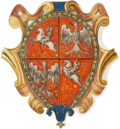| Kusza | |
|---|---|
 | |
| Details | |
| Battle cry | NE CEDE ARDIUS (Yield Not Unto Difficulties)[ citation needed ] |
| Alternative names | NIEZAPOMINAJKA (Forget-Me-Not)[ citation needed ] |
| Families | several |
Kusza (pronounced Ku-Sha) is a Polish coat of arms.
Contents
Families using the main variant of the coat are: Bystrycki, [1] [2] [3] Bystrzycki, [2] Korejwa or Koreywa, [1] [2] [3] Leszczynowicz, [3] Kosicki, [1] Kuszcz, [1] [2] [3] Kuszczyński, [1] [2] [3] Maszkiewicz, [1] [2] [3] Maślakiewicz, [1] [2] [3] Oławski, [1] [2] [3] and Otawski. [3]

